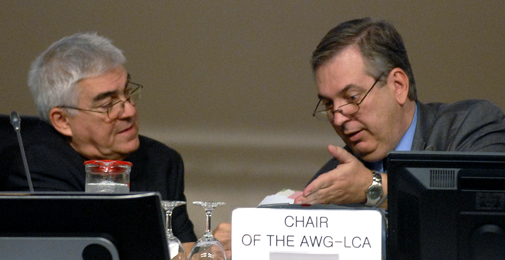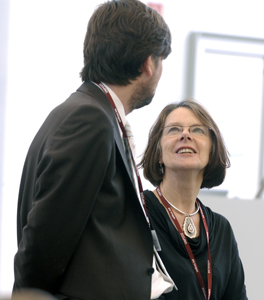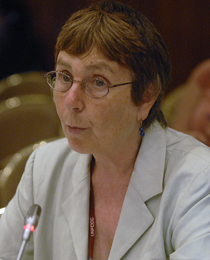|
|
|
28th Sessions of the UNFCCC Subsidiary Bodies and Sessions of the AWGs
|

|
Highlights from Tuesday, 3 June
On Tuesday, the AWG-LCA convened workshops on advancing adaptation through finance and technology, and on financial and other incentives for technology transfer. The AWG-KP considered agenda items on means to reach emission reduction targets and on methodological issues, with two contact groups meeting in the afternoon to discuss the flexible mechanisms and LULUCF. Photo: Roberto Acosta, UNFCCC Secretariat, with AWG Chair Luis Machado |
|
| Ad Hoc Working Group on Further Commitments for Annex I Parties Under the Kyoto Protocol |
| On aviation and maritime emissions, Artur Runge-Metzger, EU (left),
noted strong support to address this under the UNFCCC. |
| On aviation and maritime emissions, Mohammed Al Sabban, Saudi Arabia (left),
highlighted differences of opinion on sectoral approaches, aviation and maritime emissions, biofuels and nuclear power. Jane Hupe, International Civil Aviation Organization (ICAO) (center), described ICAO's programme of action on aviation greenhouse gas emissions, scheduled for completion in 2009.
Kuwait (right) said
said discussions on aviation and maritime emissions raise serious methodological, technical and legal concerns. |
On LULUCF, Brazil (left) said LULUCF rules should be improved but not fundamentally changed.
Sandea de Wet, South Africa, speaking for the G-77/China (center), noted the wide range of proposals on means to achieve Annex I commitments for the second commitment period, but said some proposals go beyond the legal mandate for this working group. Dessalegne Mesfin, Ethiopia (right),
noted renewed interest in unequitable geographic distribution of CDM projects. |
Evind Vagslid, International Maritime Organization (IMO)(left), described IMO's work plan on a binding instrument for all ships by 2009 and emphasized the importance of flag-neutrality in emissions treatment.
Bill Hare, Climate Action Network (center), proposed that Annex I parties auction a fraction of their emissions allowances for the second commitment period in order to raise funds for, inter alia, adaptation. James Wolf, Business Council for Sustainable Energy (right), stressed that private sector involvement can speed delivery of existing technologies.
Ad Hoc Working Group on Long-term Cooperative Action: Workshop on advancing adaptation through finance and technology, including national adaptation programmes of action (NAPAs)
|
| South Africa advocated a holistic and coherent approach to adaptation, which could inform avoidance and insurance systems, and be used for capacity building. |
Shira Yoffe, US (left), advocated a holistic and coherent approach to adaptation, which could inform avoidance and insurance systems, and be used for capacity building. China (right) proposed establishing a climate change adaptation committee under the Convention to assist work on adaptation, focused on developing countries.
|
| Ad Hoc Working Group on Long-term Cooperative Action: Workshop on Technology Transfer |
| Roberto Acosta, UNFCCC Secretariat, AWG-LCA Chair Luis Machado, ?? Helen Plume, SBSTA Chair, and Bagher Asadi, SBI Chair |
| SBI Chair Bagher Asadi highlighted linkages between work on technology transfer under the SBI and the work under the AWG-LCA, and underscored COP decision 4/CP.13 requesting the GEF to elaborate a strategic programme on technology transfer. |
Arthur Rolle, Bahamas, for AOSIS (left), suggested a register, based on Annex I submissions, of available technologies and how developing countries can utilize them. He also suggested an international fund to fast-track renewable energy technology development.
Elmer Holt, US (right), identified supportive actions that can be taken by the UNFCCC, including research, development and deployment, and capacity building. He urged a shift from a donor-based paradigm to a self-sustained process based on enabling environments and private capital flows. |
William Kojo Agyemang-Bonsu. Ghana (left),
suggested creating a technology board, with panels for different sectors. He supported the MTAF proposal and the use of credits and rewards as incentives for technology transfer.
Brazil (center) suggested creating an institutional mechanism on technology development and transfer, including special financial instruments under the UNFCCC.
The EU (right) noted the need to consider, inter alia, access to information, institutional arrangements, a transparent process, sound national policies, a shift to clean energy investment, new sources of financing, and actors. |
| Contact Group: AWG-KP LULUCF |
| This group was co-chaired by Marcelo Rocha, Brazil, and Bryan Smith, New Zealand. Discussion centered on how to structure the group's discussions. |
| Contact Group: AWG-KP Mechanisms |
| Contact Group Chair Christiana Figueres Olsen, Costa Rica (center), clarified that the group's task was to compile ideas on mechanisms as a means to reach Annex I further commitments |
 |
 |
|
|
Related IISDRS Coverage
- 28th Session of the IPCC, 9-10 April 2008, Budapest, Hungary
- First Session of the Ad Hoc Working Group on Long-Term Cooperative Action under the UN Framework Convention on Climate Change (UNFCCC) and Fifth Session of the Ad Hoc Working Group under the Kyoto Protocol, 31 March-4 April 2008, Bangkok, Thailand
- UNFCCC Expert Group Meeting on Socioeconomic Information under the Nairobi Work Programme (NWP), 10-12 March 2008, Port of Spain, Trinidad and Tobago
- UNFCCC Expert Group Meeting on Methods and Tools and on Data and Observations under the Nairobi Work Programme (NWP), 4-7 March 2008, Mexico City, Mexico
- UN Climate Change Conference in Bali (COP 13), 3-14 December 2007, Bali, Indonesia
- 27th
Session of the IPCC, 12-17 November 2007, Valencia, Spain
- UNFCCC
workshop on Adaptation, Planning and Practices under the Nairobi
Work Programme on Impacts, Vulnerability and Adaptation to
Climate, 10-12 September 2007, Rome, Italy
- Montreal
Protocol MOP19, 16-21 September 2007, Montreal, Canada
- Vienna
Climate Change Talks - AWG4 and Dialogue 4,
27-31 August 2007
- ENB coverage of the UN General Assembly's Informal Thematic Debate, 31 July–2 August 2007, New York
- IPCC
Working Group 3 and IPCC-26, 30 April-4 May 2007, Bangkok, Thailand
- UNFCCC
Asian Regional Workshop on Adaptation, 11-13 April 2007, Beijing, China
- IPCC
Working Group 2, 2-5 April 2007, Brussels, Belgium
- CTI
Joint Seminar on Technology Transfer in Asia, New Delhi, 7-8 March 2007, New Delhi, India
- Second
International Workshop on Community Based Adaptation to Climate,
24-28 February 2007, Dhaka, Bangladesh
- IPCC
Working Group I, 29 January-1 February 2007, Paris, France
- UNFCCC
COP12, 6-17 November 2006, Nairobi, Kenya
|
 Please e-mail the Digital Editor should you have any questions regarding the content of this page. Please e-mail the Digital Editor should you have any questions regarding the content of this page.
|
|